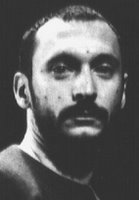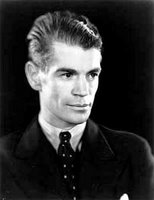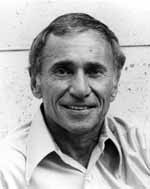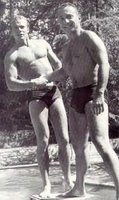 Maurice Béjart
Maurice Béjart born 1 January 1927 (d. 2007)
Maurice Béjart was one of the most influential choreographers of the twentieth and early twenty-first centuries who attracted huge audiences to ballet.
Maurice Béjart was born in Marseilles, the eldest of three children of the distinguished philosopher Gaston Berger and his wife, Germaine.
Because of his slight physique as a child a doctor recommended that the 11-year-old boy should take some form of exercise or sport. With two great interests in life, reading and the theatre, young Maurice thought dancing might be a good idea. And so it proved.
As soon as he could, he moved to Paris to study with such celebrated teachers as Leo Staats, Lubov Egorova, Nora Kiss and Madame Rousanne. Later, on the recommendation of Margot Fonteyn, he moved to London to study with Vera Volkova.
Having adopted the stage name Maurice Béjart – a homage to Molière's wife the actress Armande Béjart – he toured with several small companies. In 1949 he joined Mona Inglesby's International Ballet and danced a number of important roles, including the virtuoso Bluebird pas de deux in that company's
Sleeping Beauty. The following year he joined the company of the Swedish choreographer Birgit Cullberg, where he had his first experience of modern dance. He also worked with the Royal Swedish Ballet for a time, which led to his first film choreography and his first Stravinsky ballet,
The Firebird (1952).
Although he had been choreographing since an early age it was not until 1953, after a break caused by ill-health and obligatory military service, that Béjart formed his own small company in association with the actor and writer Jean Laurent, based at the Théâtre de l'Etoile in Paris. The most important work of this period was
Symphonie pour un homme seul, danced to the musique concrète of Pierre Henry. Béjart's musical tastes were eclectic, and he could just as happily make dances to scores by Albinoni or Gerry Mulligan, or mix electronic sound with Tchaikovsky, as he did later in
Nijinsky, Clown of God (1971).
His breakthrough came in 1959 when he created his version of
Rite of Spring for a season of dance at the Théâtre Royal de la Monnaie in Brussels. The cast was made up of dancers from his own small company, Western Theatre Ballet and Les Ballets Janine Charrat, plus the troupe from the Monnaie. The mix of theatricality and eroticism proved an instant hit and Béjart was invited to become resident choreographer at the Monnaie with a greatly enlarged company which he renamed Ballet of the Twentieth Century.
It was here that forged his reputation, making small works like Webern Opus Five and his homage to Marius Petipa,
Ni fleurs ni couronnes (a deconstructed version of the
Rose Adagio) as well as monumental works for the vast Forest National arena in Brussels. The company toured widely in Europe.

Béjart attracted some exceptional dancers, notable among them Paolo Bortoluzzi, Shonach Mirk, Maina Gielgud and the Argentinian
Jorge Donn who for more than two decades was a central focus of Béjart's life, both professionally and personally. Dancers loved working with him. Many remained with him throughout their careers, despite the modest salaries paid even to principal dancers.
Other famous dancers were happy to work with Béjart for short periods or in specially created works. For Rudolf Nureyev he made a duet,
Songs of a Wayfarer, to the Mahler song cycle, which Nureyev danced for many years. Balanchine's muse, Suzanne Farrell, was a member of the company for a period and when she left to rejoin New York City Ballet, Balanchine is said to have remarked that 'she left him as a girl and came back a woman'. Certainly her remarkable technique had not declined during her years in Brussels, since Béjart insisted on a very high standard of teaching for his dancers.

Despite the adulation surrounding him, Béjart remained entirely level-headed, living quite simply. He had a keen and often earthy sense of humour. He made no secret of his homosexuality, and he generally lived alone, even when in long-term relationships. Nor was he backward in expressing his admiration for other choreographers.
In 1987, following a dispute with Gérard Mortier, the new director of the Monnaie, Béjart moved his base from Brussels to Lausanne in Switzerland. In Lausanne he had good working conditions, complete artistic freedom and the possibility of re-establishing the dance and theatre school he had set up in Brussels. (A similar school, Mudra Afrique, operated in Dakar between 1977 and 1985).

He continued working, creating and touring widely. In all, Béjart made more than 200 ballets, besides directing operas, plays and films. Most of his work was for his own company, but he made several ballets for the Paris Opéra (he was offered the directorship there on more than one occasion but always declined). For the Deutsche Oper Berlin, he made an ambitious full-evening work,
Ring around "The Ring", which encapsulated all four of the Wagner operas.
Béjart wrote prolifically, including several volumes of autobiography and a novel,
Mathilde (1963), plus copious programme notes for his ballets.
Béjart received numerous awards and prizes during his life.
At his best, Béjart produced some of the most exciting dance theatre of our time. Among his astonishingly large output of about 220 creations, the three most likely to survive in the repertoire are his devastatingly simple but gripping
Bolero and his highly original treatments of Stravinsky's
Rite of Spring and
The Firebird. In both of these latter, characteristically, he gave more importance than usual to male dancing. His
Firebird was the leader of a partisan troop, shot and killed in battle but returning in spirit to inspire continued resistance. For
Rite, he abandoned the original idea of a single female sacrificial victim in favour of showing a man and a woman chosen to save their tribe through ritual copulation and death.
Advancing years, and sorrow at the death of some close friends, did not interrupt his activity and originality. He continued making new ballets right up to his death in late-November 2007, in spite of illness (exhaustion plus heart and kidney problems) that required his frequent admission to hospital. His final ballet,
Around the World in 80 Minutes, was premiered in Lausanne in December 2007.
Obituary in The Times
Obituary in The IndependentLabels: Ballet, Choreographers, Dancers, Theatre Directors, Writers
 Maurice Evans born 3 June 1901 (d. 1989)
Maurice Evans born 3 June 1901 (d. 1989) When World War 2 arrived, he was in charge of an Army Entertainment Section in the Central Pacific and played his famous 'G.I. version' of Hamlet that cut the text of the play to make Prince Hamlet more decisive and appealing to the troops, an interpretation so popular that he took it to Broadway in 1945. He then shifted his attention to the works of Shaw, notably as John Tanner in Man and Superman and as King Magnus in The Apple Cart. He was also a successful Broadway producer of productions in which he did not appear, notably Teahouse of the August Moon.
When World War 2 arrived, he was in charge of an Army Entertainment Section in the Central Pacific and played his famous 'G.I. version' of Hamlet that cut the text of the play to make Prince Hamlet more decisive and appealing to the troops, an interpretation so popular that he took it to Broadway in 1945. He then shifted his attention to the works of Shaw, notably as John Tanner in Man and Superman and as King Magnus in The Apple Cart. He was also a successful Broadway producer of productions in which he did not appear, notably Teahouse of the August Moon. Evans had great impact onscreen as well, memorably in two 1968 films: as the evolved orang-utan, Dr Zaius in Planet of the Apes and as Rosemary's friend Hutch in the thriller Rosemary's Baby.
Evans had great impact onscreen as well, memorably in two 1968 films: as the evolved orang-utan, Dr Zaius in Planet of the Apes and as Rosemary's friend Hutch in the thriller Rosemary's Baby.







































